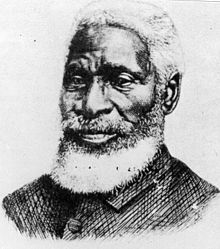User:Kbutler88/The Life of Josiah Henson, Formerly a Slave, Now an Inhabitant of Canada, as Narrated by Himself (1849)
 Josiah Henson | |
| Author | Josiah Henson |
|---|---|
| Country | United States |
| Language | English |
| Subject | Slavery in the U.S. |
| Genre | Autobiography |
| Publisher | Arthur D. Phelps |
Publication date | 1849 |
| Followed by | Truth Stranger Than Fiction. Father Henson's Story of His Own Life |
The Life of Josiah Henson, Formerly a Slave, Now an Inhabitant of Canada, as Narrated by Himself (1849) is a slave narrative written by Josiah Henson, who would later become famous for being the basis of the character of Tom from Harriet Beecher Stowe's Uncle Tom's Cabin. The Life of Josiah Henson is his first work but was dictated to Samuel A. Eliot, who was a former Boston Mayer known for his anti-slavery views because although he was an accomplished orator, Henson had not yet learned to read and write. The narrative provides a detailed description of his life as a slave in the south.
Publication History[edit]
Henson’s autobiography was published in Boston in early 1849 by Arthur D. Phelps. Over the next three years, it sold 6,000 copies It was reprinted after, with different pagination by the Observer Press of Dresden Ontario, for Uncle Tom’s Cabin and Museum in Dresden. When it was later Henson's narrative was the model for Uncle Tom’s Cabin, his sale increased to a total of 100,000 sales. In 1851 it appeared in London and Edinburg as The Life of Josiah Henson, formerly a Slave: As Narrated by Himself. It has now been reproduced by various publishing companies including Applewood Books (ISBN 155709585X) and Dover Publications (ISBN 048642863X).
Public Reception[edit]
After the publication was released in 1849 and received little public attention until Harriet Beech Stowe’s novel, Uncle Tom’s Cabin, in 1858. Soon after, it became widely believed that Hensen was the source of her work and was, in fact, Uncle Tom.
Synopsis[edit]
Advertisement[edit]
This slave narrative, begins with an ‘Advertisement.’ In the case of this book, the use of the word Advertisement is not to introduce an paid announcement to publicize a type of good or enterprise. Instead, it’s function is that of a notice to the readers to the fact that the work is the work is the authentic work of Josiah Henson. The advertisement discusses the fact that the memoir was written from a dictation given by Josiah Henson, and so, the substance of the work is his own while “little more than the structure of the sentences belongs to another.” Through the paragraph long passage, to further autheniticate the work, it expressly says that the work is “not fiction, but fact.”
References[edit]
Electronic Edition of The Life of Josiah Henson, Formerly a Slave, Now an Inhabitant of Canada [1]
The Origins of Uncle Tom's Cabin Charles Nichols The Phylon Quarterly, Vol. 19, No. 3 (3rd Qtr., 1958), pp. 328-334 Published by: Clark Atlanta University [2]
The Story of Josiah Henson W. B. Hartgrove The Journal of Negro History, Vol. 3, No. 1 (Jan., 1918), pp. 1-21 Published by: Association for the Study of African-American Life and History, Inc. [3]
Josiah Henson, the Moses of His People H. A. Tanser The Journal of Negro Education, Vol. 12, No. 4 (Autumn, 1943), pp. 630-632 Published by: Journal of Negro Education [4]
Josiah Henson's Narrative: Before and After Mary Ellen Doyle Negro American Literature Forum, Vol. 8, No. 1 (Spring, 1974), pp. 176-183 Published by: St. Louis University [5]
Who Read the Slave Narratives? Charles H. Nichols The Phylon Quarterly, Vol. 20, No. 2 (2nd Qtr., 1959), pp. 149-162 Published by: Clark Atlanta University [6]
Foster, Francis Smith. Witnessing Slavery: The Development of Antebellum Slave Narratives. University of Wisconsin Press; 2 edition ISBN 0299142140
External links[edit]
